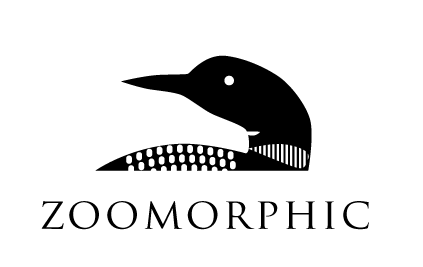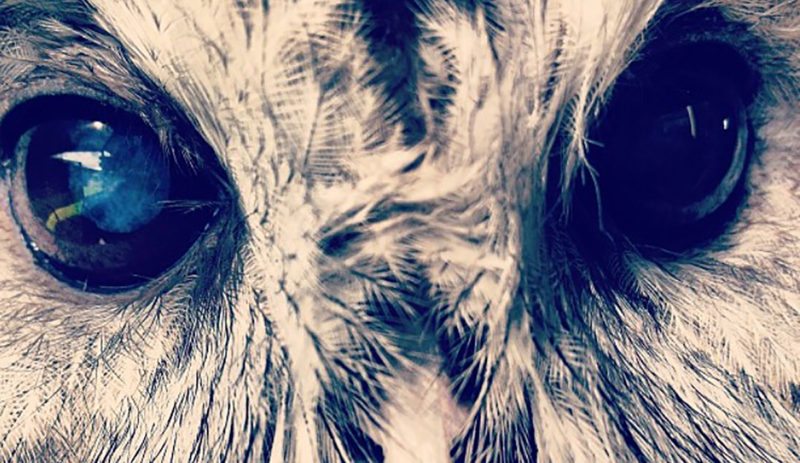by Jenna Gersie
I spent a year under the gaze of wild birds. At first, I couldn’t look into their eyes, out of respect. Slowly, I gained their trust, and they reached a level of comfort with me that they had achieved with other trainers before. I wore a thick leather glove and a hip-pack filled with pieces of mice. They wore ferocity, stoicism, and dignity. The injured wild birds who came into our care bore a type of bravery I had never seen—to remain calm and still beneath the hands of humans, to be separated from the trees for a time. Those who were residents blessed us with their individualism—I never knew these creatures could have such personalities. I had only ever seen or heard these birds at a distance before. Up close, I was always in awe.
I.
On my first day working with the avian wildlife rehabilitation team, someone brought us a barred owl, lying on an old towel in a cardboard box with holes punched in it. The owl had been hit by a car, stunned. Tara called me over to the exam table. Carrie held the owl’s taloned feet in her leather-gloved hands, using her forearms to keep the bird’s long wings tucked in at its sides. There were no visible injuries. Carefully, Tara began a thorough exam, explaining as she adeptly felt each bone beneath feathers, stretched the wings, shone a flashlight to look into the bird’s deep brown eyes. She gently blew the bird’s feathers, causing them to part and reveal the owl’s ears. I leaned in, fascinated. I had never seen a bird’s ears before, or even considered them, for that matter. I peered inside the owl’s ear: the soft pink flesh, curling into a cavern in a pattern not so different from my own. Owls’ eyes are so large, you can see the back of their eyeballs by looking into their ears; their hearing is so phenomenal, they can hear a mouse scurrying beneath the snow. Looking into the pink swirl of that ear, my own sense of hearing rushed away. Tara’s voice, the metal door slamming in the next room, the other avian patients shuffling in their enclosures—all sounded incredibly distant. “I think I need to sit down,” I barely heard myself say as I found my way to the stool in the corner. Someone helped me from the stool to the cold, cement floor as lightheadedness and nausea overcame me. This vasovagal reaction: was it mere queasiness at seeing, up close, the anatomy of the barred owl? Or somehow, in that moment, did I absorb the owl’s trauma and pain?
II.
Julia, Amy, and I stayed after work one day to learn how to splint a bird’s leg. On the counter were toothpicks, pieces of wire, Popsicle sticks, and SAM splints cut into bird-sized pieces. We would choose our splint based on the size of the bird we would use to practice. If a bird ever died in our care, we wrapped it in plastic, made a label with masking tape and a permanent marker, and kept it in the freezer, and Tara had pulled a few for the evening’s lesson. They ranged in size from a scarlet tanager to a black vulture. I chose the barred owl. Tara slid it across the counter toward me. Something caught my attention as she did: a smell that was warm and comforting, so unlike the semi-frozen cadaver that lay before me. I attempted to discretely move my face closer to the owl, whose eyelids were closed in silence. The smell wafted toward me. I moved my fingers through the breast feathers of the owl, a million times softer than I could have imagined. “This owl smells good,” I said, feeling crazy. “You’re not the first person I’ve heard say that barred owls smell good,” Tara said, moving on to a diagram of a bird’s skeleton. I leaned forward again. The owl smelled like baking. Like flour, like sugar, like a kitchen warmed by the oven. The fringes of an owl’s feathers look like eyelashes. With each detail of the owl’s body as delicate as that, it didn’t seem so strange to imagine this owl flying through the kitchen, amongst pastries, its feather tips dusting flour on the counter as they dip and dust the fresh-fallen snow.
III.
Amy had let her dishes pile up again. They filled both halves of the sink, stacked one atop the other, teetering. Sometimes you had no choice but to do them for her. This time, she brought her laptop next to the kitchen sink to watch a TV show while she washed her dishes. The hot water produced steam that rose and enshrouded the kitchen window. There was still snow on the ground, but the days were getting longer, so there was some daylight left as Julia and I went about our evenings and Amy diligently finished her task at the kitchen sink, the water running. We were in an adjoining room when we heard her shout, “HOLY SHIT! It’s a barred owl!!” She slammed her laptop shut. We both came running. We joined Amy at the kitchen window, wiped away the condensation, and looked outside. Our backyard included a deck that had started to fall apart. A single post stood about five feet tall at one corner of the deck. Perched dreamily atop the post was a barred owl, hunkered down, its feathers puffed warmly around it. It looked perfect there, with the sky approaching twilight and the brown reeds of winter swaying in the background. Amy couldn’t explain her excitement, but it didn’t matter—we all felt the same. It didn’t matter that we saw our resident barred owls at work every day; it didn’t matter that injured ones were brought into our care each week. This was a wild barred owl. It wasn’t here for the lab mice that we defrosted each evening; it wasn’t here for rest and relaxation. It was on its own, it had survived the winter, it had found food to hunt despite the snow, which lay two feet deep from November till February. We stood at the kitchen window, our breath fogging the glass more than the hot water from the faucet had, watching the owl until the sky grew dark. We never saw it move from its perch.
IV.
When the snow melted, Julia and I put on wool layers and running shoes and ran from our home on Route 4 to a side street, downhill, over the bridge, past the golf course, past the homes we could never afford. I hadn’t run since the fall, and my quads quivered and my lungs felt shallow. I carried on, trying to keep up, as we began to ascend. Julia was several hundred feet ahead of me as the pavement wound uphill around the trees whose buds had yet to bloom. The forest was still made up of browns and grays; the green-to-come was several weeks away. Around a corner, I lost sight of her, but as I continued, I saw her stopped on the side of the road, looking at the trees. She heard me approaching, and without a sound, she made eye contact with me and then pointed into the woods. I staggered uphill until I was beside her, then looked to where she pointed. There, not ten feet from the side of the road, about ten feet above our heads, a barred owl perched on a branch, napping. Its chocolatey feathers made it nearly indistinguishable from the trees that surrounded it; I wondered how Julia had spotted it. Its eyes were mostly closed, perhaps left slightly open to observe us. I was ashamed by my ragged breathing as my lungs attempted to compensate for the hill I had just climbed. The owl was so silent, so still; I was nothing but a disturbance.
V.
We kept two barred owls in an enclosure together. During the spring health check-up we gave to each of the resident birds, we found that one of the barred owls was getting too skinny. She was as old as me. Maybe the other owl in her enclosure was eating most of the food, but more likely, she was just getting old. We brought her back to the rehab enclosures to more closely monitor her food consumption. In the evenings, if I was returning a raptor to its enclosure past normal work hours, I would hear the old barred owl call across the campus: “Who cooks for you? Who cooks for you all?” The hoots and caws of her former roommate would echo back to her. All night, I imagined them calling back and forth, finding comfort in the other’s calls even when they could not find comfort in the other’s presence. Through the darkness, their calls resounded, connecting them where human-made barriers prevented their union. After a few days of separation from her partner, it was decided that perhaps being in a new enclosure was causing too much stress on the old owl, that maybe she had a better chance of gaining weight in the home she had known for the past ten years. She was moved back to her original enclosure at the end of the workday. The next morning, I unlocked the padlock that kept the gate to the bird enclosures shut. I wrapped the cold chain around a post, grateful that I hadn’t yet given up winter’s gloves, slid the gate open, and began to walk past the enclosures. The barred owls’ enclosure was after the bald eagles, golden eagles, and great horned owls. Each bird looked at me with some kind of distaste, the quiet of their early morning interrupted. But when I reached the barred owls, my heart ached at what I saw. Despite the various places designed specifically for these injured birds to find a place to perch, the two had found their place together: they sat, side by side, on a branch that hung like a swing from the roof. Their commitment to each other, throughout their nights apart, and now, reunited, was almost too much to bear. I watched them, and they stared back at me in unison.
Jenna Gersie’s writing has appeared in Orion, The Goose, Dirt, and Kudzu House, among others. She is an editor for The Hopper and Green Writers Press and teaches literature and writing at The Island School. She is passionate about learning about new places and discovering meanings of home.

